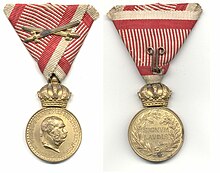Military Merit Medal (Austria)


The Military Merit Medal was donated on March 12, 1890 by Emperor Franz Joseph I as a visible distinction for "those who received the monarch's highest commendation for outstanding achievements in the war." In peacetime it was given as an expression of the "highest satisfaction" for excellent service on the "highest resolution". Also referred to as Signum Laudis after the inscription on the back ( lat. "Sign of praise"). This badge of honor replaced the former only written “Most High Commendation” of the sovereign . After all, it served as a model for the military recognition medal introduced in 2006 .
stages
The award has undergone several changes to the articles of association and was finally awarded as follows:
- Great Military Merit Medal (Gold)
- Military Merit Medal in Silver
- Military Merit Medal (Bronze)
On March 26, 1911, the military medal of merit in silver was introduced for “renewed highest honorable recognition” of the emperor. At the same time, clasps were created on the ribbon of the medal for multiple awards of the same level. On April 1, 1916, the Great Military Merit Medal was introduced, which was slightly larger than the other levels and made of gold. It was given to only 30 people as the "special and highest recognition" of the emperor. Of these, 28 were in the rank of general, the other two were in 1916 the Naval Air battleship Lieutenant Gottfried Banfield (1890 to 1986) and 1918 the Chiffrierexperte Lieutenant Colonel Hermann Pokorny (1882-1960).
On December 13, 1916, clasps were also introduced as an add-on for multiple awards for all levels of the Military Merit Medal.
Medals
The medal is a round medal (diameter 30 mm) made of gold-plated bronze , which is raised by a movably attached Austrian imperial crown. The medal shows the profile of Emperor Franz Joseph I on the obverse and a laurel and oak wreath encloses the inscription "Signum Laudis" on the reverse. The silver medal is designed identically and made of silver. There are also examples made of silver-plated bronze or silver-plated war metal. The Great Military Merit Medal has a diameter of 38 mm, the crown is framed on both sides by laurel branches. Medals, which were awarded from April 1917, show the head of Emperor Karl , the successor of Franz Joseph, and show a firmly connected elevation of the Austrian imperial crown and the Hungarian royal crown.
Ribbon
The Military Merit Medal was awarded in peacetime on a single-colored, crimson ribbon. During the war, the medal was awarded on the ponceau red and white striped ribbon of the medal of bravery (which was also used for the Military Cross of Merit ).
People who took part directly in a battle and who had distinguished themselves by “brave behavior in front of the enemy” received the ribbon with crossed swords.
When the military merit medal was awarded several times, this was indicated by attaching a or a second clasp, the so-called "repeat clasp", on the ribbon.
Carrying method
The military merit medal was worn on a triangular ribbon on the left side of the chest.
See also
- List of Austrian orders and decorations (ranking of awards)
literature
- Roman von Procházka : Austrian Order Handbook. Graf Klenau oHG, Munich 1974.
- Johann Stolzer, Christian Steeb: Austria's order from the Middle Ages to the present. Akademische Druck- und Verlagsanstalt, Graz 1996, ISBN 3-201-01649-7 , pp. 238–240.
